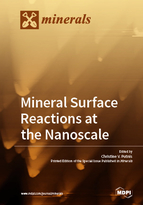Mineral Surface Reactions at the Nanoscale
A special issue of Minerals (ISSN 2075-163X). This special issue belongs to the section "Crystallography and Physical Chemistry of Minerals & Nanominerals".
Deadline for manuscript submissions: closed (30 June 2018) | Viewed by 72587
Special Issue Editor
2. The Institute for Geoscience Research, Curtin University, Perth, WA 6845, Australia
Interests: mineral surface reactions; nano-imaging using in situ AFM experiments; defining the mineral–fluid interface; nanoparticles; pre-nucleation clusters; interface-coupled dissolution-precipiation mechanism; environmental remediation; element mobilisation
Special Issue Information
Dear Colleagues,
Reactions at mineral surfaces are central to all geochemical processes. Because water is ubiquitous on Earth—at least reaching down to the crust-mantle boundary—processes occurring at the mineral–aqueous fluid interface control the evolution of the minerals making up the rocks of the Earth. Indeed, we can go as far as to say that the Earth as we know it has been shaped by reactions at mineral surfaces. Life itself is totally dependent on these mineral surface reactions that release the elements necessary for living plants and animals to exist. Thus, mineral surfaces are essential for a large range of important Earth processes. Apart from maintaining life they also control processes such as weathering of rocks and hence soil formation, biomineralization, the fate of contaminants and possible remediation strategies, including element sequestration, and on a larger scale, metamorphism, ore deposit formation and global element cycling. In recent years it has been through the development of advanced analytical methods that mineral surface reactions have been imaged and analyzed at the nanoscale. This has enabled exciting new possibilities for clarifying the mechanisms that govern mineral–fluid reactions. Industrial processes, environmental remediation and nuclear waste disposal methods, medical research and the pharmaceutical industry are all benefitting from the recent advances in understanding mineral surface reactions at the nanoscale. This Special Issue aims to highlight the role and importance of mineral surfaces in many varying fields of research.
Dr. Christine V. Putnis
Guest Editor
Manuscript Submission Information
Manuscripts should be submitted online at www.mdpi.com by registering and logging in to this website. Once you are registered, click here to go to the submission form. Manuscripts can be submitted until the deadline. All submissions that pass pre-check are peer-reviewed. Accepted papers will be published continuously in the journal (as soon as accepted) and will be listed together on the special issue website. Research articles, review articles as well as short communications are invited. For planned papers, a title and short abstract (about 100 words) can be sent to the Editorial Office for announcement on this website.
Submitted manuscripts should not have been published previously, nor be under consideration for publication elsewhere (except conference proceedings papers). All manuscripts are thoroughly refereed through a single-blind peer-review process. A guide for authors and other relevant information for submission of manuscripts is available on the Instructions for Authors page. Minerals is an international peer-reviewed open access monthly journal published by MDPI.
Please visit the Instructions for Authors page before submitting a manuscript. The Article Processing Charge (APC) for publication in this open access journal is 2400 CHF (Swiss Francs). Submitted papers should be well formatted and use good English. Authors may use MDPI's English editing service prior to publication or during author revisions.
Keywords
- mineral surface
- interface
- nanoscale
- nanoparticles
- dissolution
- crystal growth
- replacement
- coupled reactions
- environment
- contamination
- remediation
- sequestration
- element cycling






